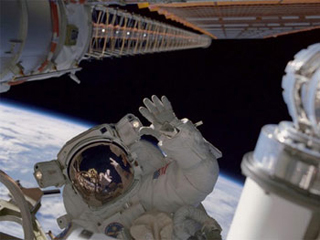
Astronaut Carlos I. Noriega waves during the second of three STS-97 sessions of extravehicular activity. (Photo courtesy of NASA.)
Instructor(s)
Prof. Dava Newman
MIT Course Number
16.423J / HST.515J / ESD.65J
As Taught In
Spring 2006
Level
Graduate
Course Description
Course Features
Course Description
This course introduces students to a quantitative approach to studying the problems of physiological adaptation in altered environments, especially microgravity and partial gravity environments. The course curriculum starts with an Introduction and Selected Topics, which provides background information on the physiological problems associated with human space flight, as well as reviewing terminology and key engineering concepts. Then curriculum modules on Bone Mechanics, Muscle Mechanics, Musculoskeletal Dynamics and Control, and the Cardiovascular System are presented. These modules start out with qualitative and biological information regarding the system and its adaptation, and progresses to a quantitative endpoint in which engineering methods are used to analyze specific problems and countermeasures. Additional course curriculum focuses on interdisciplinary topics, suggestions include extravehicular activity and life support. The final module consists of student term project work.
Other Versions
Other OCW Versions
Archived versions: ![]()


